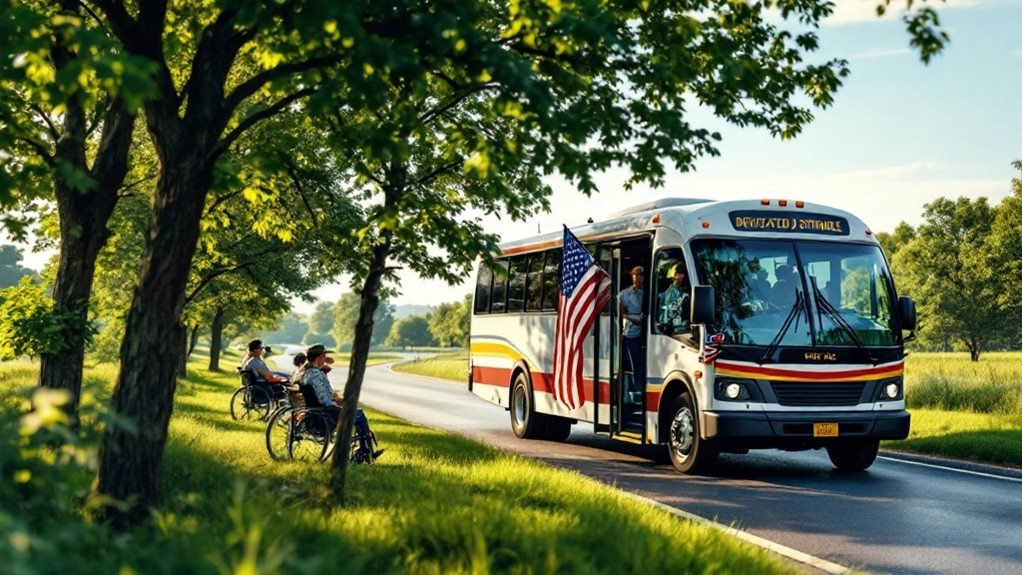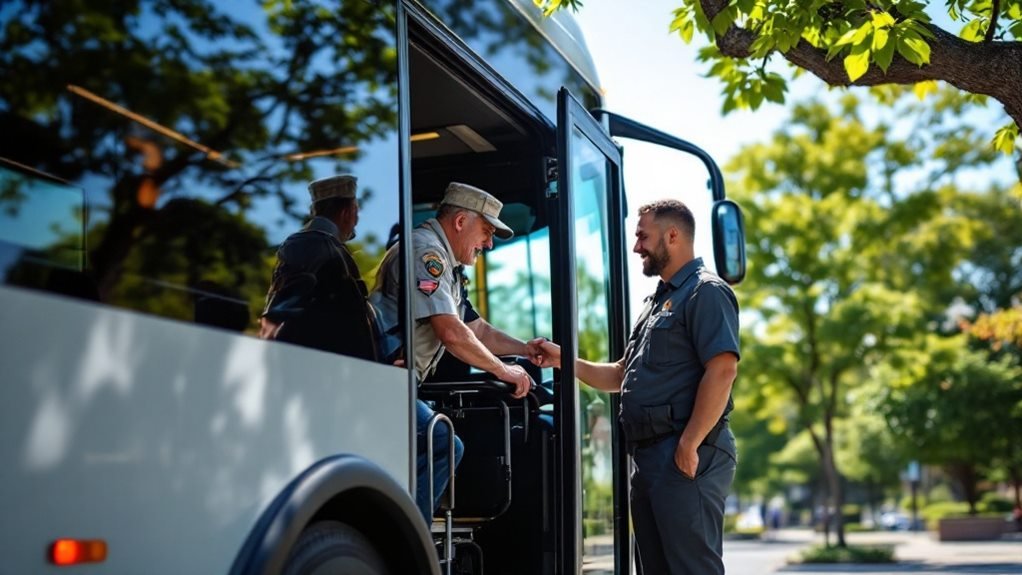Transportation pay for non-active veterans helps cover travel costs to essential medical appointments and services. It's designed to promote independence, enhance social participation, and improve our quality of life. Eligibility requires service duration, necessary medical appointments within the VA system, and income limits, which vary based on location and family size. The application involves submitting documentation like the DD214 form, travel receipts, and VA forms. We might encounter common challenges, such as maneuvering through paperwork and limited transport availability, but knowing these can aid in successful claims. There's more to discover about ensuring smooth access to these benefits.
Key Takeaways
- Transportation pay helps non-active veterans access essential services like healthcare, job opportunities, and community activities.
- Eligibility requires a minimum of 24 months active duty, linked medical appointments, and income verification.
- VA healthcare-related medical appointments qualify for transportation pay coverage.
- Income thresholds vary by geographic location and family size, influencing eligibility.
- Required documentation includes DD214 form, VA Form 10-3542, travel receipts, and medical appointment confirmations.
Understanding Transportation Pay
When it comes to understanding transportation pay for non-active veterans, it's crucial that we recognize the importance of easing their access to essential services. Many veterans face challenges in accessing medical care, job opportunities, and community activities due to transportation barriers.
By providing transportation benefits, we can help bridge these gaps, guaranteeing that veterans maintain their independence and quality of life.
Transportation benefits are a key component of veteran resources, designed to support those who've served our country. These benefits not only facilitate access to healthcare appointments but also enhance their overall well-being by enabling participation in social and community events.
We must be proactive in understanding and promoting these resources, so every veteran knows what's available to them.
Our collective responsibility is to guarantee veterans aren't left behind due to transportation issues. By spreading awareness and advocating for extensive veteran resources, we can help create a supportive environment where veterans can thrive.
Let's continue to prioritize their needs by making transportation pay a fundamental part of the support system. By doing so, we honor their service and contribute positively to their post-military lives.
Eligibility Criteria
As we explore the eligibility criteria for transportation pay, it's important to contemplate key factors that affect access for non-active veterans.
We'll look at the required service duration, ensuring veterans have served sufficient time to qualify, and the necessity of having a medical appointment as part of the eligibility.
Additionally, income threshold limits play a significant role, and understanding these can help us better assess who might benefit most from this support.
Service Duration Requirements
Understanding the service duration requirements is vital for non-active veterans seeking transportation pay. As we navigate the complexities of veteran benefits, it's important to recognize how our time in service impacts our eligibility. Typically, a minimum service duration is required to qualify for transportation pay. This guarantees that those who've dedicated a significant portion of their lives to serving their country receive the support they need when they shift back to civilian life.
Our collective commitment to helping others is reflected in the benefits provided to veterans. The service duration requirement is designed to fairly allocate resources to those who've earned them through their dedication and sacrifice. Generally, veterans who've completed at least 24 continuous months of active duty, or the full period for which they were called to active duty, are considered eligible.
However, there are exceptions, particularly for those who've been discharged due to service-connected disabilities or other specific conditions. By understanding these criteria, we can better advocate for ourselves and our fellow veterans, making sure we receive the benefits we're entitled to, and continue our journey of serving others, even beyond active duty.
Medical Appointment Necessity
To qualify for transportation pay, it's essential for non-active veterans to understand the medical appointment necessity criteria. We all know how important it's for veterans to attend their medical appointments, guaranteeing their well-being and continued care.
When it comes to transportation options, veterans need to verify that their medical appointments are linked to VA healthcare services. The appointments should be scheduled through the VA system to qualify for transportation pay.
Transportation pay is aimed at easing the burden of getting to necessary appointments, especially when mobility or financial constraints pose challenges. It's critical that we make sure the appointment scheduling is aligned with the VA-approved services. This not only includes regular check-ups but also specialty care, mental health services, and any follow-up treatments directly connected to a veteran's VA healthcare plan.
As we navigate the eligibility criteria, let's keep in mind the significance of these appointments in the broader context of a veteran's health journey. By understanding the necessity behind each medical visit, we can better appreciate the support that transportation pay offers, ultimately fostering a healthier, more supported community of veterans who've given so much to serve others.
Income Threshold Limits
When considering transportation pay eligibility, it's important to explore the income threshold limits that help determine which non-active veterans can receive this benefit.
As we navigate this process, we must understand that income verification plays a vital role. The Department of Veterans Affairs (VA) sets specific thresholds to guarantee that transportation benefits reach those who need them most. By verifying income, the VA can assess whether a veteran's financial situation qualifies them for this assistance, assuring fair and equitable distribution.
To qualify, a veteran's annual household income must fall below a set threshold, which varies depending on geographic location and family size.
This means that veterans residing in areas with a higher cost of living may have different limits compared to those in more affordable regions. It's essential for us to gather all necessary documentation, like tax returns and income statements, to accurately report our financial status.
Application Process
How exactly do we navigate the application process for transportation pay as non-active veterans? Let's break it down together.
First, we need to explore the transportation options available to us. Understanding these options will help us determine the best route suited for our needs. We can start by visiting the Veterans Affairs (VA) website, where a wealth of veteran resources is readily accessible. This platform provides essential information regarding eligibility and the steps required to apply.
Once we've familiarized ourselves with the available resources, it's important to reach out to a local veteran service officer (VSO). They're an invaluable resource, offering guidance and support tailored to our unique situations. A VSO can assist us in completing the application, guaranteeing we accurately fill out the necessary details.
Engaging with fellow veterans who've already navigated this process can also be beneficial. Their experiences might highlight nuances we might overlook.
Required Documentation
As we navigate the process of securing transportation pay, let's guarantee we gather the necessary forms and applications meticulously.
It's essential we include proof of service eligibility, such as a DD214, to substantiate our veteran status.
Necessary Forms and Applications
Maneuvering the process of obtaining transportation pay for non-active veterans requires careful attention to the necessary forms and applications. As we initiate this journey, it's vital that we gather all required documentation to guarantee a smooth application process for these transportation benefits.
We acknowledge that veterans seeking assistance deserve a process that's as straightforward and stress-free as possible.
First, let's guarantee we've the correct forms. The primary form for requesting transportation benefits is the VA Form 10-3542, which covers travel reimbursement for eligible veterans. It's important to complete this form accurately, noting all travel expenses related to medical appointments and services.
This form can be accessed online through the VA's website or obtained from a local VA office.
Additionally, we must provide supporting documents, such as travel receipts and medical appointment confirmations. These documents validate the expenses and guarantee that the application is processed without unnecessary delays.
It's our role to meticulously gather and organize these papers, reinforcing our commitment to serving those who served us.
Proof of Service Eligibility
Understanding the proof of service eligibility is essential for veterans seeking transportation pay, and we're here to make certain you have all the necessary documentation. Maneuvering the world of veteran benefits can be overwhelming, but with the right information, you'll be empowered to claim what you're entitled to.
The first step in this journey is service verification, which confirms your status as a veteran eligible for these benefits. To verify your service, you'll need a copy of your DD214 form, also known as the Certificate of Release or Discharge from Active Duty. This document serves as the cornerstone for validating your service history, detailing your period of military service, discharge status, and more.
If you don't have a DD214, you can request one through the National Archives website, guaranteeing you have this vital piece of documentation. Additionally, it's helpful to have any other service records that might further establish your eligibility, such as awards, commendations, or a VA benefits letter.
Covered Expenses
When discussing covered expenses for transportation pay for non-active veterans, it's vital we grasp the nuances of what's included. The benefits provided are designed to assist veterans in accessing necessary services, guaranteeing their well-being and honoring their service.
Understanding the various transportation options is essential, as these options are often directly linked to the veteran benefits available. Typically, covered expenses include costs related to travel for medical care, such as appointments at VA hospitals or clinics. This might encompass mileage reimbursement for personal vehicle use, public transportation fares, or even specialized services like wheelchair-accessible vans if needed.
Our goal is to guarantee that no veteran faces barriers in accessing healthcare due to transportation challenges. Moreover, some programs may cover additional expenses, such as meals and lodging, if the medical care requires overnight stays.
It's important for us to carefully review the specific benefits available, as they can vary based on individual circumstances and the distance traveled. By staying informed and advocating for thorough support, we can help guarantee that veterans receive the care they deserve without undue financial burden.
Together, we can make a significant difference in their lives.
Reimbursement Procedures
Maneuvering through the reimbursement procedures for transportation pay can initially seem intimidating, but we're here to simplify the process.
First, let's understand the core steps. Accuracy and timeliness are vital, so gather all necessary documents, including receipts and proof of travel. These documents help guarantee smooth processing.
Submit the completed reimbursement claim to the relevant VA office either online or in person, depending on your preference and convenience.
Understanding reimbursement timelines is essential. Typically, the VA aims to process claims within 30 days, but it's wise to follow up if it takes longer. Keeping track of submission dates and maintaining copies of all documents can help us stay organized and prepared for any discrepancies.
When it comes to reimbursement methods, the VA usually offers direct deposit as the most efficient way to receive funds. Confirm your banking details are up-to-date to avoid delays.
Alternatively, if direct deposit isn't an option, a paper check can be issued.
Common Challenges
Maneuvering the complexities of VA transportation reimbursement can often feel like an uphill battle, but knowing the common challenges can help us better prepare. One primary hurdle is understanding the array of transportation options available to us. The VA offers several programs, yet deciphering which one aligns with our specific needs and eligibility can be overwhelming.
Whether it's the Beneficiary Travel program or other veteran benefits, we must navigate a sea of information to choose the right path.
Another challenge involves the paperwork and documentation required for reimbursement. Gathering all necessary forms, receipts, and verifications can be intimidating, especially when each claim seems to demand a different set of documents.
These requirements can lead to delays or even denials, leaving us feeling frustrated and unsure of how to proceed.
Additionally, we often face logistical barriers in accessing transportation options. Limited availability or inconvenient scheduling can make it difficult to attend necessary appointments.
As we endeavor to serve others, we recognize the importance of addressing these concerns to guarantee our fellow veterans receive the support they deserve. By identifying and understanding these challenges, we can work together to advocate for smoother processes and more accessible veteran benefits.
Tips for Successful Claims
To navigate the complexities of filing successful claims for VA transportation reimbursement, it's vital we equip ourselves with a clear strategy.
First, let's gather all relevant documentation. Every trip or appointment needs verification, so keeping consistent records will streamline the process. We should also familiarize ourselves with veteran resources available to us, such as online portals and local VA offices that offer guidance and support.
Our next step is understanding the specific eligibility requirements. We need to guarantee our claim strategies align with these criteria to avoid unnecessary delays. It's essential to review the VA's guidelines regularly, as policies can change. Engaging with fellow veterans can be invaluable; they often share practical insights from their own experiences.
When it comes to submitting the claim, attention to detail is key. Double-check all forms for accuracy before submission. Mistakes, even minor ones, can lead to rejection or processing delays.
Conclusion
In summary, we've explored the ins and outs of transportation pay for non-active veterans, ensuring you're well-prepared to navigate the process. While it might seem intimidating at first, remember that understanding the eligibility criteria, application steps, and required documentation can greatly ease your journey. Don't worry if the process feels complex; we're here to guide you every step of the way. By following our tips and advice, you'll be well on your way to successful claims and well-deserved reimbursements.



